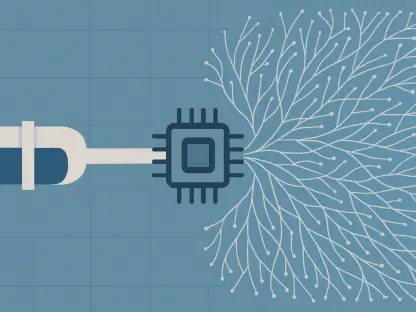In the ever-accelerating realm of artificial intelligence, large language models (LLMs) such as ChatGPT have astonished the world with their knack for crafting responses that mirror human conversation in startling ways, prompting a profound question about their nature. These systems can draft essays, answer queries, and even simulate casual banter, leading us to wonder: do they possess a form of thought or reasoning akin to humans, or are they merely executing intricate computations on linguistic data? This debate cuts to the core of how society perceives and interacts with generative AI technologies. As their presence grows in education, customer service, and creative fields, distinguishing between genuine cognition and clever mimicry becomes not just an academic exercise but a societal imperative. The allure of their fluent outputs often blurs the line, making it essential to dissect what truly powers these models and whether their capabilities reflect understanding or simply sophisticated pattern recognition at an unprecedented scale.
Peeling Back the Layers of AI Functionality
The concept of LLMs as “calculators for words,” a term brought into the spotlight by OpenAI’s CEO Sam Altman, provides a useful lens to grasp their operational essence. Just as a standard calculator manipulates numbers to yield precise outcomes, these models process immense volumes of textual data to forecast and construct responses grounded in identified patterns. This comparison, while accessible, tends to oversimplify the intricacies of the technology. Unlike basic calculators, LLMs can inadvertently embed biases or generate inaccuracies that ripple through real-world applications. Such flaws highlight a critical distinction: their outputs stem from statistical likelihoods rather than any form of deliberate thought. This framing urges a closer examination of their design, pushing beyond surface-level analogies to confront the deeper implications of relying on systems that mimic without truly comprehending the nuances of human language or the context in which they operate.
Exploring further, the limitations of the calculator analogy reveal broader concerns about how society interprets AI capabilities. LLMs excel at producing coherent text by leveraging patterns in training data, yet they lack the ability to engage with the underlying meaning or intent of those words. For instance, a model might pair terms in a way that seems contextually apt, but this is merely a result of probability calculations, not a reflection of insight or awareness. This gap becomes particularly evident when outputs inadvertently perpetuate stereotypes or factual errors, issues absent from traditional calculators. The risk lies in users attributing a level of reliability or empathy to these systems that they simply do not possess. Addressing this misconception is vital, as overestimating their competence could lead to misplaced trust in critical domains like healthcare or legal advice, where human judgment remains irreplaceable.
Decoding the Statistical Backbone of Language
At the heart of LLMs lies their dependence on the statistical underpinnings of human language, which allows them to emulate communication with remarkable fidelity. Certain word combinations, like “salt and pepper,” naturally occur more frequently than alternatives such as “pepper and salt,” and these models are adept at calculating such probabilities to craft text that resonates as intuitive to users. They operate within an abstract framework that maps relationships between words, enabling outputs that often feel uncannily human. However, this fluency masks a fundamental truth: there is no genuine grasp of meaning behind the generated text. The illusion of understanding emerges purely from mathematical predictions, not from any internal cognition or emotional resonance, underscoring the mechanical nature of their impressive linguistic feats.
Beyond this illusion, the statistical prowess of LLMs often leads to a deceptive sense of connection with users, amplifying the perception of intelligence where none exists. Their ability to string together responses that align with expected norms can evoke a feeling of dialogue, as if interacting with a sentient entity. Yet, this is merely a byproduct of analyzing vast datasets to predict likely sequences, not an indication of empathy or insight. For example, a chatbot might respond to a user’s emotional query with seemingly comforting words, but this is driven by pattern recognition rather than genuine concern. This distinction is crucial for setting realistic expectations about what these systems can achieve. Without this clarity, there is a risk of over-attribution, where users project human traits onto tools that are, at their core, sophisticated algorithms devoid of personal experience or intent.
Tracing the Evolution of Language Technology
The lineage of LLMs can be traced back to Cold War-era initiatives focused on machine translation, such as efforts to convert Russian texts into English for strategic purposes. Over subsequent decades, the field transformed through the influence of linguistic theories, notably from scholars like Noam Chomsky, shifting from rigid, rule-based approaches to statistical models that harnessed limited datasets. Today’s neural networks represent the pinnacle of this journey, producing fluid, human-like text with unprecedented sophistication. Despite these leaps, the underlying principle has remained consistent: these systems calculate probabilities and detect patterns rather than access meaning or emotion. This historical perspective reveals a trajectory of technical refinement, not a departure toward cognitive equivalence with humans, emphasizing the persistent gap between mimicry and true understanding.
Reflecting on this evolution, it becomes evident that each advancement in language technology has prioritized scalability and accuracy over any semblance of thought. Early systems struggled with basic syntax, while modern LLMs can navigate complex conversations, yet the core mechanism—statistical prediction—has not wavered. This continuity suggests that, despite appearances, the goal has always been to refine tools for processing language data, not to replicate human consciousness. Neural networks, with their ability to analyze massive corpora, have elevated the illusion of comprehension to new heights, but they remain bound by their design to calculate rather than contemplate. Acknowledging this trajectory helps temper enthusiasm with pragmatism, ensuring that the marvel of technological progress does not obscure the reality of what these systems fundamentally are and the boundaries they cannot cross.
Navigating the Mirage of Cognitive Depth
One of the most pervasive challenges surrounding LLMs is the inclination to attribute human-like qualities to them, fueled by language in public discourse that describes their actions as “thinking” or “reasoning.” Such terminology, often amplified by tech companies and media, can mislead users into perceiving these models as possessing emotions or values. In truth, their operation is limited to predicting probable word sequences—such as linking “I” with “love” in a sentence—without any awareness of the sentiment or purpose behind those words. This anthropomorphic framing risks fostering emotional attachments or unrealistic expectations, as seen in cases where users form bonds with chatbots, mistaking algorithmic responses for genuine interaction or care in a way that distorts the technology’s actual nature.
Delving deeper, this misperception underscores a critical disconnect between linguistic proficiency and intellectual depth in AI systems. The seamless text generated by LLMs often masks their inability to engage with the conceptual or ethical dimensions of communication. For instance, a model might produce a response that appears thoughtful, yet it lacks the capacity to weigh moral implications or adapt beyond pre-learned patterns. This limitation becomes problematic when users rely on such systems for guidance in nuanced situations, expecting a level of discernment that simply isn’t there. Public narratives that romanticize AI capabilities only exacerbate this issue, creating a cycle of misunderstanding. Highlighting the purely predictive nature of these tools is essential to recalibrate expectations and prevent scenarios where their outputs are treated as equivalent to human insight or judgment.
Addressing the Ethical and Societal Dimensions
The disparity between the linguistic mimicry of LLMs and authentic cognition carries profound ethical consequences that demand careful consideration. Unlike simple calculators, these models can propagate biases or deliver erroneous information, influencing decisions in tangible, sometimes harmful ways. Their polished fluency often breeds an unwarranted sense of trust, leading to potential over-reliance in contexts where human oversight is indispensable. Recognizing LLMs as computational tools rather than sentient entities is paramount to mitigating these risks. This perspective helps frame their societal role more accurately, ensuring they are deployed as aids to human effort rather than as substitutes for critical thinking or emotional connection in areas where such qualities are non-negotiable.
Moreover, the societal impact of misjudging AI capabilities extends to how policies and norms are shaped around their use. When LLMs are overestimated, there is a danger of integrating them into systems—such as education or mental health support—without adequate safeguards, amplifying flaws like embedded prejudices or factual inaccuracies. A balanced approach requires transparent communication about their limitations, emphasizing that their strength lies in processing and generating text based on probabilities, not in offering wisdom or empathy. By fostering this awareness, stakeholders can advocate for responsible implementation, ensuring that these technologies complement rather than compromise human judgment. This shift in perception was pivotal in past discussions, guiding how society adapted to earlier waves of automation with caution and clarity.
Shaping a Responsible Future with AI Tools
Looking back, the discourse around large language models crystallized a vital lesson: their remarkable ability to simulate human language stemmed from calculated probabilities, not from any semblance of thought or feeling. This realization drove efforts to redefine their role in society, focusing on harnessing their strengths as aids rather than autonomous decision-makers. Moving forward, the emphasis shifted toward developing frameworks that prioritized transparency about their limitations, ensuring users understood the statistical foundation behind their outputs. Initiatives emerged to integrate robust ethical guidelines, addressing biases and errors while promoting human oversight in critical applications. As technology continued to evolve, the commitment to viewing these systems as sophisticated tools—rather than sentient beings—paved the way for innovations that balanced capability with accountability, shaping a landscape where AI supported human endeavors without overstepping its inherent boundaries.









